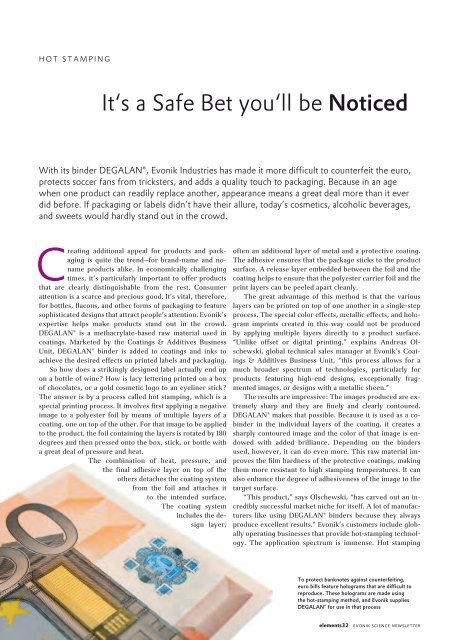Download - Evonik Industries
Download - Evonik Industries
Download - Evonik Industries
Create successful ePaper yourself
Turn your PDF publications into a flip-book with our unique Google optimized e-Paper software.
H o t S t A M P i n G<br />
it‘s a Safe Bet you‘ll be Noticed<br />
with its binder DeGAlAn®, evonik industries has made it more difficult to counterfeit the euro,<br />
protects soccer fans from tricksters, and adds a quality touch to packaging. Because in an age<br />
when one product can readily replace another, appearance means a great deal more than it ever<br />
did before. if packaging or labels didn’t have their allure, today’s cosmetics, alcoholic beverages,<br />
and sweets would hardly stand out in the crowd.<br />
Creating additional appeal for products and packaging<br />
is quite the trend—for brand-name and noname<br />
products alike. In economically challenging<br />
times, it’s particularly important to offer products<br />
that are clearly distinguishable from the rest. Consumer<br />
attention is a scarce and precious good. It’s vital, therefore,<br />
for bottles, flacons, and other forms of packaging to feature<br />
sophisticated designs that attract people’s attention. <strong>Evonik</strong>’s<br />
expertise helps make products stand out in the crowd.<br />
DEGALAN® is a methacrylate-based raw material used in<br />
coatings. Marketed by the Coatings & Additives Business<br />
Unit, DEGALAN® binder is added to coatings and inks to<br />
achieve the desired effects on printed labels and packaging.<br />
So how does a strikingly designed label actually end up<br />
on a bottle of wine? How is lacy lettering printed on a box<br />
of chocolates, or a gold cosmetic logo to an eyeliner stick?<br />
The answer is by a process called hot stamping, which is a<br />
special printing process. It involves first applying a negative<br />
image to a polyester foil by means of multiple layers of a<br />
coating, one on top of the other. For that image to be applied<br />
to the product, the foil containing the layers is rotated by 180<br />
degrees and then pressed onto the box, stick, or bottle with<br />
a great deal of pressure and heat.<br />
The combination of heat, pressure, and<br />
the final adhesive layer on top of the<br />
others detaches the coating system<br />
from the foil and attaches it<br />
to the intended surface.<br />
The coat ing system<br />
includes the design<br />
layer,<br />
often an additional layer of metal and a protective coating.<br />
The adhesive ensures that the package sticks to the product<br />
surface. A release layer embedded between the foil and the<br />
coating helps to ensure that the polyester carrier foil and the<br />
print layers can be peeled apart cleanly.<br />
The great advantage of this method is that the various<br />
layers can be printed on top of one another in a single-step<br />
process. The special color effects, metallic effects, and hologram<br />
imprints created in this way could not be produced<br />
by applying multiple layers directly to a product surface.<br />
“Unlike offset or digital printing,” explains Andreas Olschews<br />
ki, global technical sales manager at <strong>Evonik</strong>’s Coatings<br />
& Additives Business Unit, “this process allows for a<br />
much broader spectrum of technologies, particularly for<br />
products featuring high-end designs, exceptionally frag-<br />
mented images, or designs with a metallic sheen.”<br />
The results are impressive: The images produced are extremely<br />
sharp and they are finely and clearly contoured.<br />
DEGALAN® makes that possible. Because it is used as a cobin<br />
der in the individual layers of the coating, it creates a<br />
sharply contoured image and the color of that image is endowed<br />
with added brilliance. Depending on the binders<br />
used, however, it can do even more. This raw material improves<br />
the film hardness of the protective coatings, making<br />
them more resistant to high stamping temperatures. It can<br />
also enhance the degree of adhesiveness of the image to the<br />
target surface.<br />
“This product,” says Olschewski, “has carved out an incredibly<br />
successful market niche for itself. A lot of manufacturers<br />
like using DEGALAN® binders because they always<br />
produce excellent results.” <strong>Evonik</strong>’s customers include globally<br />
operating businesses that provide hot-stamping technology.<br />
The application spectrum is immense. Hot stamping<br />
To protect banknotes against counterfeiting,<br />
euro bills feature holograms that are difficult to<br />
reproduce. These holograms are made using<br />
the hot-stamping method, and <strong>Evonik</strong> supplies<br />
DEGALAN® for use in that process<br />
elements32 evonik science newsletter

















